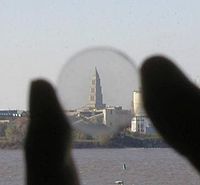
Photo from wikipedia
Characteristics of a diffusion-bonded sapphire cell for optical experiments with hot metal vapors were investigated. The sapphire cell consisted of sapphire-crystal plates and a borosilicate-glass tube, which were bonded to… Click to show full abstract
Characteristics of a diffusion-bonded sapphire cell for optical experiments with hot metal vapors were investigated. The sapphire cell consisted of sapphire-crystal plates and a borosilicate-glass tube, which were bonded to each other by diffusion bonding without any binders or glues. The glass tube was attached to a vacuum manifold using the standard method applied in glass processing, filled with a small amount of Rb metal by chasing with a torch, and then sealed. The cell was baked at high temperatures, and optical experiments were then performed using rubidium atoms at room temperature. The sapphire cell was found to be vacuum tight, at least up to 350°C, and the sapphire walls remained clear over all temperatures. From the optical experiments, the generation of a background gas was indicated after baking at 200°C. The background gas pressure was low enough to avoid pressure broadening of absorption lines but high enough to cause velocity-changing collisions of Rb atoms. The generated gas pressure decreased at higher temperatures, probably due to chemical reactions.
Journal Title: Applied optics
Year Published: 2018
Link to full text (if available)
Share on Social Media: Sign Up to like & get
recommendations!